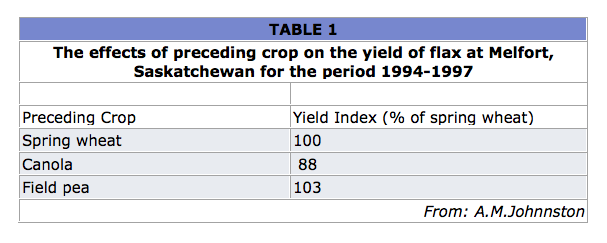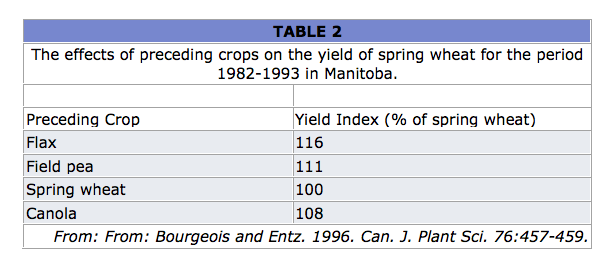Crop Rotation
Flax is predominantly a stubble-sown crop in Manitoba. It is also increasing as a stubble crop in Alberta and Saskatchewan where currently more than 50% is grown on stubble. A broad spectrum of herbicides is available to control both broadleaf and grassy weeds, including volunteer cereals.
Following Canola or Mustard
Research in Saskatchewan has shown that flax sometimes does poorly after canola or mustard.
This is due to toxic compounds in mature canola and mustard plants and their seedling residues. However, research in Manitoba has shown that flax yields on canola stubble were generally not affected, although small reductions occurred in some years. The problem is most evident where straw and trash from the previous canola crop have not been adequately spread on the soil surface. Canola straw should, therefore, be spread uniformly, and spring volunteer seedlings should be controlled at an early stage in order to minimize possible toxic effects. Seeding into untilled canola stubble can also minimize the problem.
The poorer performance of flax on canola stubble can also be attributed to mycorrhizae fungi, which do not associate as strongly with canola roots as with flax roots. When flax is grown on canola stubble, the mycorrhizae populations tend to be lower. Mycorrhizae fungi, in their relationships to roots, will increase and improve nutrient uptake, especially phosphorus, a relatively immobile nutrient in the soil.
Following Other Crops
Flax does well after cereals or corn. It also does well after legume crops, but Rhizoctonia disease may be a problem. Flax does not do well after potatoes or sugar beets as the soil may be too loose and Rhizoctonia disease could also be a problem.
Flax does very well on alfalfa breaking as was observed by alfalfa producers in north-east Saskatchewan. Recent work at the Melfort Research Farm has demonstrated that flax will perform well on spring wheat and field pea stubble relative to canola stubble (see Table 1). Seeding flax on flax stubble will yield similar to flax on canola stubble. Seeding canola on flax stubble is preferable to flax on canola stubble.
 Crop rotation of at least three years between flax crops is recommended for controlling various soil-borne or stubble-borne diseases of flax (see Chapter 8 for the specific flax diseases).
Crop rotation of at least three years between flax crops is recommended for controlling various soil-borne or stubble-borne diseases of flax (see Chapter 8 for the specific flax diseases).
OTHER CROPS FOLLOWING FLAX
Information from Manitoba and Saskatchewan has shown that crops like spring wheat will yield well on flax stubble (see Table 2).
Soil Zones
Brown and Dark Brown Soil Zones
Flax is adapted to Brown and Dark Brown soils of the Prairies. With adequate weed control, the major factor influencing the yield of flax in a rotation for the Brown and Dark Brown soil zones is the availability of moisture. Because of its shallow rooting character, flax extracts 95% or more of its water from the top 71 cm (28 in.) of soil.
It appears that flax yields better on medium to heavy textured and fertile soils.
Although lack of moisture limits yields, it also allows for a high carry-over of nutrients. Therefore, it is important to fertilize according to soil test results in order to get optimum returns from the addition of fertilizer.
Flax leaves little residue on the land, thus increasing the risk of wind erosion if the land is summer-fallowed after a flax crop. Ideally, flax should be followed by a cereal in the rotation.
Black and Dark Grey/Grey Soil Zones
Flax fits into a rotation easily in the Black and Dark Grey/Grey soil zones across the Prairies, providing producers with an alternative to cereals and canola. Crop sequence studies at Melfort, Saskatchewan, have shown that flax produced higher yields on wheat and barley stubble than it did on canola, flax or oat stubble. Here, moisture is less of a yield-limiting factor than in the Brown and Dark Brown soil zones.
At Indian Head, Saskatchewan, wheat following flax showed no reduction in yield, therefore, making wheat the most acceptable crop to follow flax. Barley also performed well on flax stubble.

